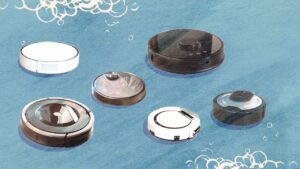In 1883, Austrian watchmaker Josef Pallweber designed a unique timepiece display mechanism that he subsequently licensed to the International Watch Company. Rather than use conventional watch hands, his system featured rotating discs inscribed with the minutes and hours, which were hidden beneath the watch’s main dial. As the time progressed and the discs revolved, the appropriate hour and minutes were revealed via small cutout windows. However, rather than slowly advancing to the following minute or hour, the discs “jumped” into place. This combination of windows and jumping discs—which debuted in a series of I.W.C. pocket watches in 1885—constituted one of the earliest “jump hour” (or “digital”) watches, and one of the earliest “guichet” watches.
“Guichet,” French for the type of window at a ticket counter in, say, a train station or bank, also describes an aperture in a watch dial through which the time is read. Though this type of timepiece never proliferated to the extent that it posed any type of legitimate competition to the conventional setup with hours, minutes, and seconds hands, its relative rarity has made it a collectable commodity and a source of fascination for collectors. To wit: Cartier’s wildly covetable Tank à Guichets—perhaps the most notable guichet watch of them all—debuted in 1928 in a small production run. Worn by the likes of no less an august personality than Duke Ellington, it featured a steel dial through which the hours were read via a small aperture at 12 o’clock and the minutes via a larger cutaway in an arc at 6 o’clock.
If you’re wondering why there’s such a renewed focus on this rare horological novelty, well, that’s Cartier’s doing. At Watches and Wonders 2025, the French watch and jewelry maker reintroduced its Tank à Guichets in four references. Three of them (in yellow gold, rose gold, and platinum) pay homage to the original. But a fourth model in a platinum case—limited to just 200 examples—offers a slanted take on the 1928 design: Its hours window sits at 10 o’clock, and its minutes window is at 6 o’clock.
This “digital” watch—the product of the fertile, creative culture of early-20th-century Cartier—has subsequently been released in limited series to much fanfare over the decades. (Ironically, with its stark steel dial, it looks perhaps even more “armored” than the Tank Normale of the First World War, the design of which was inspired by an early Renault armored fighting vehicle.) The Tank à Guichet is also notable for being Cartier’s first timepiece with jumping hours, a feature that often goes hand-in-hand with guichet watches. Indeed, the terminology concerning these types of timepieces often becomes blurred, but if we were to speak more technically:
Guichet: French for “ticket window” or “small window,” a “guichet” is a small aperture in a watch through which the time (hours or minutes) is read. (Technically, an “outsize” date display is often read through this type of aperture, but watches with outsize dates and conventional time displays aren’t generally referred to as “guichet” watches.)
Jump Hour: A type of “digital” hour display in which a disc inscribed with the hours rotates behind an aperture on the watch dial. Rather than slowly transitioning from one hour to the next, an impulse within the movement causes the hour to “jump” cleanly from one to the other.
Outsize Date: A type of date display in which the date is viewed via a large aperture on the dial rather than a small one at 3 or 6 o’clock. Often—though not always—this type of display uses two apertures and two rotating discs to create its “digital” appearance. Sometimes, these discs “jump” in the manner of jump hour displays.
Digital Display: Not to be confused with the LCD or LED readout on a quartz-powered watch, this type of display describes one that is read via a numerical readout rather than with conventional watch hands. (For example, a jump hour aperture, which uses numerals to show the hour, is a type of digital display.)
Watchmakers large and small continue to iterate upon the guichet concept, turning out compelling designs that challenge the concept of the “window” display. From the playful Horological Machines of MB&F to the classically inspired reissues from Cartier, these guichet timepieces offer an inventive and unconventional rendering of time in a thought-provoking manner. Though these types of watches will always be rare (and thus expensive), this is part of the charm that accompanies the out-of-the-box thinking of the intrepid creatives behind their design. Here, a look at the most notable models worth hunting for right now.
-
Cartier Tank à Guichets
Image Credit: Mr. Watchley Introduced in 1928, the Tank à Guichet features a solid dial in which an aperture displays jumping hours at 12 o’clock, below which a secondary aperture displays dragging minutes. Worn by Duke Ellington, the model was reintroduced in 1996 in a run of just three pieces (three in gold and three in platinum) as well as a run of 150 pieces in platinum for the brand’s 150th anniversary in 1997. Finally, in 2005, Cartier produced 100 pieces as part of its elite Collection Privée Cartier Paris (“CPCP”) line. All in all, there are fewer than 400 Tank à Guichet examples across all series in existence, making this notable Cartier an extremely rare bird, indeed.
Reference: No ref. (1928); No ref. (1996); Ref. 2817 (1997)
Case Sizes: 25mm (1931); 24mm (1996); 26mm (1997)
Movement: E.W.C. hand-wound (1931); Calibre 7252 MC hand-wound (1996); Calibre 9752 MC hand-wound (1997)
Price on Secondary Market: $100,000+ -
Cartier Privé Tank à Guichets in Platinum

Image Credit: Cartier This special piece is one of the two revived Tank à Guichets designs for 2025, both of which are powered by manual wind movements. This one, in a platinum case, positions the hours at 10 o’clock and the minutes at 4 o’clock. It’s a literal slant from the other models released this year, and is available in a limited edition of just 200 pieces.
Case Size: 37.6 x 24.8 mm
Case Material: Platinum
Strap: Black Alligator
Price: Limited to 200, $61,000 -
Cartier Privé Tank à Guichets

Image Credit: Cartier If, for some reason, you can’t get your hands on the limited edition, you still have options. Cartier will offer three additional references: One in yellow gold, one in rose gold, and a third in platinum. Each of them is an homage to the original 1928 Tank à Guichets and places the hours at 12 o’clock and the minutes at 6 o’clock. What’s more, the color of each numeral track has been precision-engineered to match their alligator straps: dark green for the yellow gold, dark gray for the rose gold, and burgundy for the platinum version.
Case Size: 37.6 x 24.8 mm
Case Material: Yellow gold, rose gold, and platinum
Strap: Alligator
Price: $47,700 in rose gold and yellow gold; $55,500 in platinum -
IWC Tribute to Pallweber Edition “150 Years”
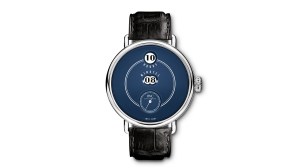
Image Credit: IWC Launched in 2017, the Tribute to Pallweber Edition 150 Years honors Josef Pallweber’s brilliant 19th-century jump-hour display that IWC successfully adopted into a series of pocket watches. Measuring 45mm in diameter, these modern, oversized wrist-worn versions of Pallweber’s system are powered by the brand’s manually-wound Caliber 94200 movement with 60 hours of power reserve. Introduced initially in red gold with a white lacquer dial, the watch was later made available in a stainless steel case with a blue dial as well as in a stainless steel case with a white dial.
References: IW505001; IW505002; IW505003
Case Size: 45mm
Movement: IWC Caliber 94200 hand-wound
Price on Secondary Market: $25,000 to $33,000 -
A. Lange & Söhne Zeitwerk Ref. 142.031
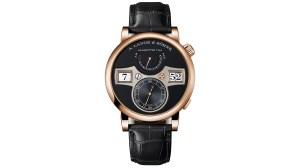
Image Credit: A. Lange & Söhne This current-collection take on Lange’s brilliant Zeitwerk is a brilliant piece of modern haute horlogerie. Housed in pink gold, its black-coated dial is crafted from German silver. While the hours are displayed via a single jumping disc at 9 o’clock, the minutes are shown on dual jumping discs at 3 o’clock. (An elegant running seconds display above 6 o’clock and a power reserve indicator at 12 o’clock complete the symmetrical picture.) Powered by the brand’s gorgeously decorated, in-house L.043.6 movement with a constant-force escapement, it’s a study in both elegance and ingenuity.
Reference: 142.031
Case Size: 41.9mm
Movement: A. Lange & Söhne Cal. L.043.6 hand-wound
Price: Upon request -
Louis Vuitton Tambour Convergence
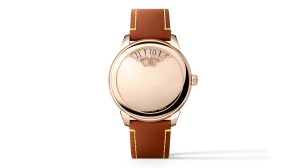
Image Credit: Louis Vuitton Released in 2025 and named for the “convergence” of the maison’s various métiers—movement making, case making, etc.—the Tambour Convergence melds a classically-inspired guichet display with a modern automatic movement designed by La Fabrique du Temps Louis Vuitton. Available in rose gold with a matching, solid rose gold dial or in platinum with a snow-set diamond dial, it features excellent 37mm x 8mm proportions and beautifully sculpted lugs reminiscent of those from important 20th-century references from the “Holy Trinity” brands. (Elsewhere in the Tambour collection, Louis Vuitton is doing even more adventurous things with its novel Spin Time system.)
Reference: W9PG11 (pink gold); W9PT11 (platinum)
Case Size: 37mm
Movement: Caliber LFT MA01.01 automatic
Price: $33,500 (pink gold); $60,500 (platinum) -
Bulgari X MB&F Serpenti
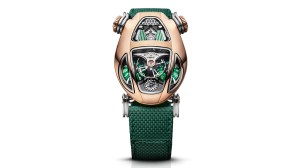
Image Credit: MB&F While we admit that the following watch perhaps stretches the definition (loose as it is) of a “guichet” timepiece, we argue that seeing as it features windows onto rotating displays, it qualifies as such. The new Bulgari X MB&F Serpenti—the first Serpenti designed with men in mind, though it could just as easily be worn by women—is the result of the passion and creativity of two brilliant minds, Bulgari’s Fabrizio Buonamassa Stigliani and MB&F’s Max Büsser. Inspired by automobiles and serpents, it features several windows—windshields, if you will!—through which one views dragging hour and minute discs within.
Reference: N/A (rose gold; titanium; and PVD steel versions available)
Case Size: 39mm
Movement: MB&F hand-wound
Price: $148,000 (steel and titanium versions); $170,000 (rose gold) -
Chaumet Jump Hour Ref. 10A
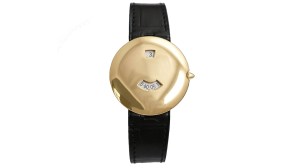
Image Credit: Mr. Watchley Chaumet’s history as a watchmaker dates back to the late 18th century—in fact, not long after its establishment in Paris, it became the jeweler to the court of Napoleon I. The Ref. 10A, which debuted in 1992, features heavily modified ETA 2892-2 movement in a jump hour design of beautiful proportions. Measuring 36mm in steel or yellow gold and featuring a recessed crown, its round shape and integrated lugs make for a beautiful, seamless design somewhat reminiscent of the “disco volante” watches from A.P., Vacheron Constantin, and others.
Reference: 10A
Case Size: 36mm
Movement: ETA 28292-2 automatic
Price: $10,000 to $24,000 (depending upon metal)
Authors
-

Oren Hartov
Oren Hartov covers the watch industry for Robb Report, GQ, Esquire, MONOCLE, and more. A graduate of the Berklee College of Music and a military veteran, he can be found writing songs and playing…
Credit: robbreport.com









